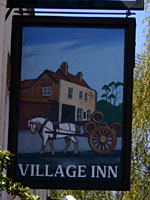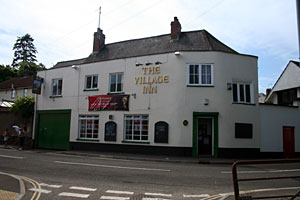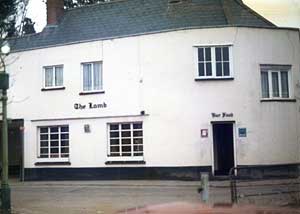
The Village Inn
Page updated 30 January 2010
 The Village Inn has a long history in Exwick,
starting life in 1832 as the John Bull. The footprint of the present
inn, coincides, with that of Exwick Manor House, the home of the
Olivers and later, for a brief period, Anthony Gibbs, father of William
Gibbs of Tyntesfield, who became the richest merchant in England from
the sale of guano, a fertiliser, during the 19th Century. The cob wall
bounding St Andrew's Road, and sections of some external and internal
walls of the inn, appear to date from the manor house.
The Village Inn has a long history in Exwick,
starting life in 1832 as the John Bull. The footprint of the present
inn, coincides, with that of Exwick Manor House, the home of the
Olivers and later, for a brief period, Anthony Gibbs, father of William
Gibbs of Tyntesfield, who became the richest merchant in England from
the sale of guano, a fertiliser, during the 19th Century. The cob wall
bounding St Andrew's Road, and sections of some external and internal
walls of the inn, appear to date from the manor house.
Exwick Manor House was put up for sale, along with the rest of the estate, by the executors of Vicary Gibbs in 1830. In the same year, the Beer House Act was passed, allowing anyone to pay a 2 guinea fee to open a beer and cider house in their front room. It would appear that the new occupier of the premises took advantage and opened as a beer house, with the name John Bull. It was certainly referred to in the 1841 census and 1844 Pigots directory as the John Bull Taverne.
In 1848 Thomas Shapter mentions the inn, in his book about the cholera outbreak of 1832, albeit with the name that it was then known as, the Lamb Inn. He wrote that the landlord was summoned before the St Thomas Board of Health for advertising a forthcoming wrestling match at the inn, while the cholera outbreak was raging through the city. He promised to cancel the match and bills were printed advertising the cancellation and a special constable appointed to keep a watch and ensure compliance with the order.
Tracing the history of a public house throws up suicides, deaths and marriages. This piece appeared on 14 September 1854 in the Flying Post and marks a marriage between the Lamb, and the George & Dragon in Blackboy Road.
"September 13, at St Thomas the Apostle, by the Rev W. H. Howard, Mr. George Ash, of the George and Dragon Inn, St Sidwell's, Exeter, to Mrs Charlotte Sawdye, of the Lamb Inn, Exwick".
The week before the wedding, the inn was used for an inquest into the death of a lad named Denham, of St Thomas who was drowned in the Exe by St David's Station. A verdict of accidental death was recorded. In the November a report appeared that a man was missing who last been seen in the Lamb – his basket was found in the river two days later and the water dragged, but he was not found.
A notice for sale appeared, also in the Flying Post in May 1865.
MESSRS WARE and
SON will offer for SALE, by Auction, at the LAMB INN, Exwick on
TUESDAY, the 16th day of MAY instant, at Three o'Clock in the
Afternoon, all that old
established and well frequented
HOSTELRY, called "THE LAMB INN," situate in Exwick, and now and for
many years past in the occupation of Mr. Henry Hayman; also, a Cottage
or Dwelling House adjoining the above
Inn, now in the occupation of Mr. Bennett.
The above Inn is situate near the Bristol and Exeter Railway
Station and several factories.
Mr. Hayman has kindly consented to show the premises and
particulars may be obtained either of the AUCTIONEERS; or of
Mr. JOHN POPE, Solicitor,
5, Gandy-street, Exeter.
Dated Paris-street, May 2nd, 1865.
A case of poisoning
An interesting inquest was held at the Lamb into a mysterious case of poisoning in 1890. Mr John Dew, of Exwick, found his wife Anne dead, early on a Friday morning. He told the Deputy-Coroner, Mr Gould, that at 6pm on the previous evening his wife, who was 51, was laying on the bed when he came home from work - he said to her "Why don't you get up and do some mangling?" She replied that she would very soon. At 10pm, still on the bed undressed, she requested a cup of tea. He took her the tea, of which Mrs Dew drank half and then told her husband she wanted to go to sleep, so he left her. Mr Dew slept downstairs that night and the next morning at a quarter to six, Mr Dew went to see his wife and found her quite dead. Mrs Dew's body was was on her side, on the bed – her eyes were dilated, and she was black around the mouth and nose, possible signs of poisoning. He told the coroner that his wife was in the habit of drinking alcoholic liquors. By the bed were two bottles and a glass – the bottles were labelled as containing liniment which his daughter used to apply to her legs. Mr Dew had no reason to think his wife had committed suicide. The Dew's two sons gave evidence, stating they did not think their mother had been intoxicated that evening. Louisa Bond, of Exwick, called in to Mrs Dew with some mangling that evening, and stated that Mrs Dew was complaining of feeling very cold, but was not intoxicated. The contents of one of the bottles and glass was found by a chemist to contain ammonia and belladonna. Dr Vlieland also gave evidence and recalled that six months previously he had Mrs Dew taken into hospital after she had taken Keating's insect powder mixed in a cup. The coroner stated that death was caused by taking belladonna, but that there was no evidence that it was accidental or deliberate.
The 20th century
During the early years of the last century, the inn was often used for social events such as the Monday evening whist drive, and for public meetings. A skittle alley was built when a cottage, occupied by a Mr Woodgate, on the side of the inn was removed. There were also two cottages at the rear of the inn which have since been lost.
Two men from Exwick were taken prisoner by the Boers at Colenso and imprisoned at Waterval, while fighting in the Boer War. After they were released in 1907, Pte W Bearmore and Pte Heard of the 2nd Devons were treated to a Welcome Celebration at the Lamb Inn, where 50 dined to hear their story. Pte Heard gave an account of the Battle of Colenso and their life as prisoners of war in Waterval to the assembled audience.
It was modernised by St Anne's Well Brewery, the owners, in 1958. An article in the Express and Echo in 1977 described it thus "The Lamb Inn, Exwick - a former Judges house, has all the characteristics of an Olde Worlde Inn, even down to a heavy wooden beam obtained from Dartmoor Prison, which is incorporated in the present extension." However, I have doubts as to the authenticity of this story.
It was in 1987 that the Lamb's name was changed to the Village Inn. The fabric of the building has deteriorate over the years, and in 2009 cracks were found in a front cob wall that were considered to be structurally dangerous. Scaffolding was put up for the wall to be rebuilt, and due to the narrow road in the front, temporary traffic lights were installed to control the traffic, and prevent the scaffolding from being damaged.
Here are a few of the landlords from 1832:
1832 - Lamb Inn (John
Bull?) - a
wrestling match at the inn was cancelled due to the cholera
1841 -
John Bull - William Wood - census
1844 - John Bull Taverne - John
Alfred Cullum - Pigot's Directory
1850 - Lamb, Jno. Moore, Exwick, victualler - White's
1851 -
Lamb Inn, Joseph Sawdye, licensed victualler - census
1865 - Lamb
Inn - Henry Hayman - a for sale notice
1871 - Lamb inn p.h. exwick Hayman, H., - Pocket Journal
1879 - Lamb, Exwick, Harry Smith Hayman - White's
1881 - Hayman, 60, innkeeper, Son, son-in-law and niece - census return
1897 - Lamb, Harry Smith - Kelly's (The same as above?)
1906 - Lamb, Harry Pattern - Besley's
1912 May - Charles Austin
1918 April - Lamb, William Henry Newberry - Kelly's
1924 January - Frederick John Westcott Moore
1932 January - Walter John Howard
1936 January - C Frost
1949 January - G H Summers
1954 April -
Stanley Montague Blackmore (died 1957)
1957 November - Mrs Marcia Gwendoline Stapley Blackmore (widow)
1959
April - Henry Bartholomew
1964 May - Frederick William Curran
1987 - The Village Inn
Source: Various trade directories, Trewman's Exeter Flying Post.

The Village Inn
from St Andrews
Road.
The Village Inn from the area
that the old leat crossed.

The Lamb Inn.
│ Top of Page │